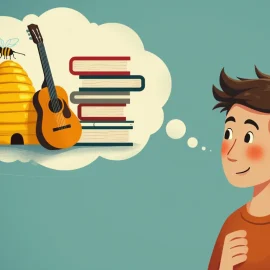
How does the brain create that sweet feeling of happiness? Why is happiness defined as a survival mechanism?
Loretta Breuning says that by understanding how your brain achieves happiness, you can rewire it to build positive, sustainable happiness habits. In Habits of a Happy Brain, Breuning discusses the brain chemistry of happiness, how harmful happiness-seeking patterns develop, and her methods for building and maintaining healthier happiness habits.
Read more in our Habits of a Happy Brain book overview.
Habits of a Happy Brain Overview
While most people spend their lives chasing happiness, their efforts are often counterproductive. In her book Habits of a Happy Brain, Loretta Breuning explains that our brains evolved to reward behaviors that helped our ancestors survive. Activities like eating triggered “happy” chemicals, encouraging them to engage in activities that promoted survival, like hunting for food. In modern times, we’ve replaced those effort-based rewards with quick fixes—like binge-eating candy—that offer instant gratification but leave us unfulfilled. Over time, these quick fixes become habits that are difficult to break.
However, there’s hope: Breuning says that by understanding how your brain achieves happiness, you can rewire it to build positive, sustainable happiness habits instead. Breuning is a professor emerita of management at California State University East Bay. She is also the founder of the Inner Mammal Institute, which aims to help people understand their brain chemistry to feel good and take control of their lives, and is the author of numerous books, including The Science of Positivity, Why You’re Unhappy, and Status Games.
Why and How We Pursue Happiness
According to Breuning, happiness is a survival mechanism—things that ensure survival make us happy, so we seek them out, and things that threaten us make us unhappy, so we avoid them. For example, eating makes us happy because it provides nutrition for survival, and the happiness we get from eating encourages us to regularly seek food so we can continue eating (and surviving). Going somewhere alone might cause unhappiness because of your fear of social isolation—something that threatened our ancestors’ survival by making them vulnerable to predators.
Breuning explains that as we age, we learn what produces happiness and unhappiness based on our experiences. Experiences form neural pathways in our brains—networks of neurons that communicate using electrical and chemical signals. When an experience triggers the release of chemicals associated with feelings like happiness or dissatisfaction, the brain takes note, and the more that associated neural pathway is used, the stronger it becomes moving forward.
For example, suppose you felt unhappy when attending a new school as a child because of the sense of isolation it caused. This formed a neural pathway in your brain between doing things alone and unhappiness. Moving forward, you felt anxious every time you had to do something alone, and this reinforced the neural pathway between being on your own and unhappiness. Likewise, you may have associated eating cheeseburgers with pleasure. Your brain then learned that cheeseburgers lead to happiness, so you regularly eat them to feel happy, reinforcing that neural pathway.
Our “Happiness” Chemicals
Breuning says that happiness and unhappiness are triggered depending on which chemical is released at the end of a neural pathway. If endorphin, dopamine, serotonin, or oxytocin lies at the end of a pathway, we end up happy. If a pathway produces cortisol, our stress hormone, we become unhappy. In this section, we’ll discuss each of our “happy” chemicals, their purpose, and the types of behaviors that trigger them.
1. Endorphin: Endorphin helps us reach safety when we’re injured by temporarily masking physical pain and providing euphoria. Our bodies use small amounts of endorphin when doing things like normal exercise, crying, and laughing, and it produces higher amounts during intense physical exertion that exceeds our limitations. Endorphin can also be mimicked by drugs like morphine or heroin.
2. Dopamine: Dopamine encourages us to strive for what we want by providing excitement and satisfaction when we anticipate or achieve the fulfillment of a need. For example, when you anticipate the nice dinner you’ll have tonight, dopamine makes you happy and excited before the event even takes place.
3. Serotonin: Serotonin encourages us to achieve high social standing and rewards us with happiness when we obtain respect or increased importance. For example, your brain releases serotonin and makes you feel happy when your boss gives you a shoutout in the company email.
4. Oxytocin: Oxytocin encourages social bonding. It provides us with happiness when we feel supported by our community, when we feel trusted, and when we experience physical touch.
Our “Unhappy” Chemical
Breuning explains that unlike the chemicals listed above, cortisol is a hormone that’s released in response to stress, making us feel unhappy and dissatisfied. When there’s an imminent threat, cortisol surges and you experience fear, which helps you handle the perceived danger. However, when your brain releases small amounts of cortisol over time, it’s because your body is trying to keep you alert to potential future problems.
Breuning points out that the stress and anxiety caused by cortisol motivates us to protect ourselves. For example, our ancestors might have experienced a slow release of cortisol when they noticed their food supply dwindling, encouraging them to spend more time hunting and foraging so as not to run out. Despite causing discomfort, cortisol is just as important as the “happy” chemicals because discomfort drives us to work harder to stay safe and meet our needs.
Our Constant Desire for Happiness Is Problematic
Breuning explains that because happiness and unhappiness are both caused by temporary chemical releases, neither state is constant. Happiness chemicals are released as a direct result of an experience and quickly fade. Likewise, cortisol eventually returns to its normal level to help us handle and anticipate threats, as we discussed in the previous section. This system evolved to encourage our ancestors to seek happiness by doing things that would ensure their survival—planting food, building shelter, enjoying a warm fire, finding a mate, and so on. If their happiness from doing those things once were to last, they wouldn’t have been encouraged to keep doing them.
Breuning explains that we’re still trapped in this cycle of chasing happiness, but because fulfilling our needs has become a lot easier, we often engage in happiness quick-fixes rather than the difficult but rewarding behaviors our ancestors took part in. For example, we can grab a cheeseburger from McDonald’s anytime we want for a quick boost of dopamine rather than having to forage for food as our ancestors did.
These happiness quick-fixes lead to a toxic cycle because we use them again and again, but their eventual consequences make us unhappy. For example, binging on cheeseburgers may be temporarily pleasurable, but it will eventually make you gain weight and feel unhappy. However, if you’ve already activated the neural pathway between eating cheeseburgers and releasing dopamine (happiness) many times, it’s become a prominent pathway in your brain. This makes it a habit that you struggle to break, even though you know it’ll make you unhappy in the end.
We Know Quick-Fixes Are Bad—Why Are They So Hard to Change?
We know that the more we use a neural pathway, the easier it is to continue using that pathway in the future—but why is this the case, and why is it so hard to build new, healthier neural connections? Breuling explains that prominent neural pathways are hard to rewire because we form them during childhood—most of our neural network is formed by the time we’re seven years old. We then reinforce these networks over years of repetition and emotional experiences.
According to Brueling, building neural pathways during childhood is easy because of myelination. Neural pathways are formed when neurons transmit electrical signals, and myelination is the process by which neurons develop a fatty coating that lets them conduct electricity better and send signals more effectively. Rewiring networks becomes increasingly difficult after we’re eight years old because the process of myelination significantly slows down. Therefore, not only do our existing neural pathways function as neuron magnets, making it hard not to use them, but our ability to build new pathways to override them grows weaker as we age.
However, Breuling explains that overcoming quick-fixes and replacing them with healthy happiness habits isn’t hopeless—you can do so using two tools: repetition and emotional experiences.
Repetition helps build new neural connections in two ways. First, it forms synapses (the connections between neurons) and allows them to transmit signals more efficiently. If we think of neural pathways as a neighborhood postal service, neurons as postal workers, and synapses as streets, increasing synaptic efficiency is akin to having well-laid-out streets that let postal workers deliver mail quickly. Low synaptic efficiency could prevent or delay the mail delivery. Emotional experiences help build neural connections because they can form synapses instantly—however, these synapses must be maintained through repetition or they’ll diminish.
Second, the brain’s number of neural connections and receptors increases and decreases based on how often they’re used. Increasing neural connections is like adding more postal workers to the network, making it even faster to send mail. Receptors are like mailboxes—they’re the gates where the neurons’ signals (pieces of mail) arrive. The more gates there are, the more signals can arrive to be translated into thoughts and feelings. This helps you better process your emotions, and it creates more “gates” where happiness can be received.
How to Produce Happiness Chemicals with Good Habits
Now that we know how to form new neural connections that lead to happiness, Breuning recommends a number of healthy behaviors you can start practicing to produce each of the four happiness chemicals and form positive habits over 45 days.
Producing Endorphin
Breuning recommends four strategies to produce endorphin, the chemical linked to increasing pleasure and reducing physical pain:
- Incorporate things into your life that make you laugh—the kind of laughter that has your shoulders shaking. For example, singing karaoke with your friends.
- Allow yourself to cry when the urge arises—not only will this release the tension from cortisol, but the exertion will also release endorphin.
- Find new ways to exercise so you’re using new muscles rather than straining the same ones—this will release small amounts of endorphin.
- Stretching daily can help release endorphin, and because it feels good, it gives you something to look forward to.
Producing Dopamine
Breuning offers three healthy strategies to produce dopamine, the chemical linked most closely with fulfillment and satisfaction.
- Divide goals and tasks into small steps and take action. Spending a few minutes a day working toward a larger goal produces dopamine from a sense of accomplishing the task and through the anticipation of your goal getting closer. This is especially true if the task is something you were dreading.
- Keep adjusting your goals—for example, if your goal is to work on something for an hour each day, it may be difficult at first, but eventually it will be easy. When this happens, it will stop feeling like an achievement, and you’ll need to alter your goal to be a bit more difficult.
- Consistently acknowledge small achievements—for example, waking up on time and eating a healthy breakfast. You can accomplish these small achievements daily to regularly produce dopamine.
Producing Serotonin
Breuning discusses four strategies to healthily produce serotonin, the chemical connected to feelings of self-worth:
- Take pride in yourself and express that pride to others, rather than seeking approval. This will reinforce your self-worth while simultaneously earning respect from others.
- Look for ways you’ve influenced others rather than ways you’re better than they are. Breuning says to be especially careful not to take pride in being better than others as this creates negative energy.
- Enjoy whatever social position you’re in at the moment. Social status is always changing, and there are pros and cons for each position. If you’re in a position where you’re in control, enjoy your power of choice and the respect you get from others. If you’re a subordinate, enjoy taking a step back and not having as much responsibility and pressure.
- Lower stress by letting go of your need for control. Breuning says to identify your control-seeking habits and do the opposite. If you need to have an exact plan every time you meet friends, let others plan or be OK with not having a plan. This will produce more serotonin by helping you feel safe even when you’re not completely in control.
Producing Oxytocin
Finally, Breuning offers four strategies to help produce oxytocin, the chemical linked to social bonding:
- Practice simple trust. Building deep, trusting relationships is a complex process, but in the meantime, you can practice smaller acts of trust like interacting with pets, online friends, or random patrons of a coffee shop. When you have these interactions, take notice of the positive feelings you experience to boost your oxytocin production.
- Take small steps to build trusting relationships with people around you. For example, offer your difficult neighbor a smile every day until you eventually feel comfortable enough to start a conversation, gradually interacting more until you establish a level of trust.
- Go out of your way to create opportunities for others to trust you. Giving a passing smile is easy, but going out of your way to offer your neighbor a burger from your barbecue is a more effortful sign of goodwill.
- Learning to trust others by cautiously extending trust to new people and checking that your trust is warranted—did your trust in others get the results you were looking for? Verifying your trust will help you grow more comfortable extending reasonable trust outside of your circle, and more trust equals more oxytocin.
How to Maintain Happiness
Breuning explains that rewiring your neural pathways to establish healthy methods for seeking happiness requires more than just repetition and emotional experiences. You must also overcome obstacles that prevent you from taking action to be happy, and find ways to make happiness a natural part of your inner landscape.
Overcoming Obstacles
Breuning explains that rewiring your neural pathways requires anticipating and overcoming obstacles that could throw you off track. When you start to rewire your neural pathways, you need to make a plan for which happiness-seeking habits you want to form and practice daily. However, there are a number of natural obstacles you might face that could disrupt your momentum and throw you off course.
The first obstacle Breuning discusses is the inability to make choices that support your effort to develop healthy habits. Breuning explains that there will be many dichotomous opportunities for happiness that will arise, and you’ll have to choose one or the other—long-term rewards versus short-term rewards, familiarity versus new experiences, or independence versus being provided for. In each case, you can’t always have both, so you’ll have to sacrifice one opportunity for another. She emphasizes that there’s no inherent right or wrong answer to the dichotomies you’ll face. The key to making the right choice is to weigh the pros and cons of each and decide which is more beneficial—don’t act solely on impulse.
Breuning also discusses barriers that could hold you back—false beliefs that impact your ability to implement new habits. These can be either internal or external. Internal barriers are beliefs about yourself that keep you from taking action. For example, you might be so afraid of failing that you never try; you might believe you only deserve happiness once you earn it; or you might make excuses that lead to negative mindsets like rumination. External barriers are beliefs about the world that prevent you from happiness. For example, you might believe that happiness should come naturally, so there’s no point in working for it, or that your unhappiness is due to society or external circumstances and is therefore unchangeable.
To overcome these barriers, Breuning recommends remembering four facts: First, you have autonomy over your mindset, actions, and happiness. Second, you don’t need to earn happiness to deserve it—if you want it, it’s yours. Third, you should focus on yourself rather than comparing yourself to others—you never know the full story behind others’ circumstances, and putting your attention on them diverts attention from your own efforts. Finally, you shouldn’t be afraid of failure and discomfort—failing teaches us what’s necessary to succeed, and success requires pushing your limits, which can be uncomfortable.
Rely on Natural Crutches
Finally, Breuning offers a few techniques to help you adopt new habits.
First, Breuning recommends engaging in behaviors that naturally form habits: Spend time around and mimic people who already practice your desired habits; connect new habits to things you enjoy; and connect new habits to ways to leave your legacy—something humans are naturally motivated to do. For example, if one of your dopamine-producing goals is to get better at writing, focus that energy into writing a book that people can read even after you’re gone.
Second, Breuning says to find ways to make habit formation more manageable for your brain: Break tasks into smaller pieces, learn to accept the good over the perfect, visualize yourself making progress when outward progress isn’t visible, and focus on the positive.
Third, manage your mental landscape: Create a balance of happy chemicals rather than favoring one chemical or method over others. You can conserve your mental energy by performing new habits and tasks in the morning when you have more energy, or by doing something you enjoy before or after.






